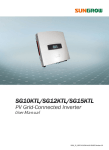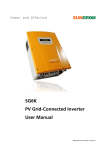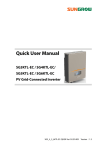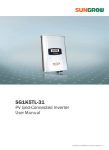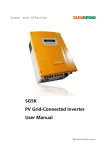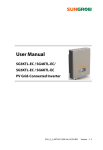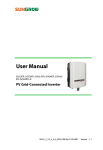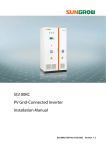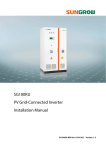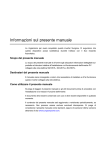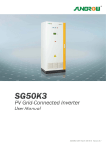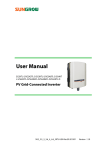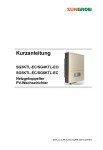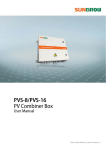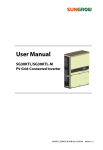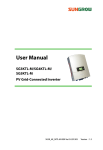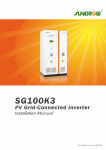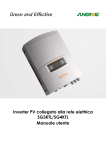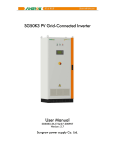Download "user manual"
Transcript
About This Manual This manual is for the inverter SG2K5TL-31, SG3KTL-31 and SG4KTL-31. These inverters are grid-connected, transformer-less, robust and of high conversion efficiency. The device will bring you more profits from PV power system. Aim The manual contains information about the inverter, which will provide you guidelines to connect the inverter into the PV power system and operate the inverter. Related Documents The manual cannot include complete information about the PV system. You will get the additional information about other devices at www.sungrowpower.com/download or via webpage of device manufacturer. Target Group The manual is targeted to technical personnel who is responsible for inverter installation and commissioning in the PV power system and inverter owner who will perform daily LCD operation. How to Use This Manual Read this manual and other related documents before any work with the inverter. Documents must be stored carefully and available at all times. The contents of the manual due to the product development will be periodically updated or revised. It is probably that there are changes of manual in subsequent inverter edition. The latest manual can be acquired via visiting the web page www.sungrowpower.com. I Symbols Explanation Important instructions contained in this manual should be followed during installation, operation and maintenance of the inverter. And they will be highlighted by these symbols. DANGER indicates a hazard with a high level of risk which, if not avoided, will result in death or serious injury. WARNING indicates a hazard with a medium level of risk which, if not avoided, could result in death or serious injury. CAUTION indicates a hazard with a low level of risk which, if not avoided, could result in minor or moderate injury. NOTICE indicates a situation which, if not avoided, could result in equipment or property damage. NOTE indicates additional information, emphasized contents or tips to help you solve problems or save time. II Symbols on the Inverter Body This symbol indicates that you should wait at least 10 minutes after disconnecting the inverter from the utility grid and from the PV input before touching any inner live parts. Hot surface! In order to reduce the risk of burns, do not touch device hot surface when the device is running. Look over the user manual before any operation onto the inverter! The installation and service of the inverter unit can only be performed by qualified personnel. Do not disconnect DC connectors from the unit under load! III IV Contents 1 Safety Instructions ................................................................................................. 1 2 Product Introduction .............................................................................................. 7 2.1 Intended Usage ................................................................................................................................ 7 2.2 Product Description .......................................................................................................................... 8 2.2.1 Product Appearance ................................................................................................................. 8 2.2.2 Dimensions and Weight of Inverter .......................................................................................... 9 2.2.3 LCD Display Panel ................................................................................................................... 9 2.2.4 DC Switch ............................................................................................................................... 10 2.3 Technical Description .......................................................................................................................11 2.3.1 Principle Description................................................................................................................11 2.3.2 Functions Description ..............................................................................................................11 3 Workflow about Inverter .................................................................................... 13 4 Unpacking and Storage ....................................................................................... 15 4.1 Unpacking and Inspection .............................................................................................................. 15 4.2 Identifying Inverter .......................................................................................................................... 16 4.3 Delivery Contents ........................................................................................................................... 17 4.4 Storage of Inverter .......................................................................................................................... 18 5 Installing Inverter onto Wall.............................................................................. 19 5.1 Selecting Installation Location ........................................................................................................ 19 5.2 Moving Inverter to Installation Site ................................................................................................. 22 5.3 Installation Procedure ..................................................................................................................... 23 6 Electrical Connection ........................................................................................... 25 6.1 Terminals Description ..................................................................................................................... 25 6.2 Simplified Electrical Connection Diagram....................................................................................... 26 6.3 Connecting Inverter to AC Grid ....................................................................................................... 27 6.3.1 AC Side Requirements ........................................................................................................... 27 6.3.2 Assembling AC Connector with Cables .................................................................................. 29 6.3.3 Connecting Inverter to AC Grid .............................................................................................. 31 6.4 Connecting Inverter to PV Arrays ................................................................................................... 32 6.4.1 Assembling DC Cable to Connector....................................................................................... 32 6.4.2 Wiring Procedures .................................................................................................................. 34 6.5 PV System Grounding .................................................................................................................... 35 I 6.6 Communication Connection............................................................................................................ 36 6.6.1 Communication Types ............................................................................................................ 36 6.6.2 RS485 Communication Connection ....................................................................................... 36 7 Commissioning ..................................................................................................... 39 7.1 Verify before Commissioning .......................................................................................................... 39 7.2 Commissioning Procedures ............................................................................................................ 39 8 Disconnection of Inverter ................................................................................... 41 9 Troubleshooting ................................................................................................... 43 9.1 Troubleshooting of LED Indicator ................................................................................................... 43 9.1.1 Troubleshooting of LED Indicator ........................................................................................... 43 9.1.2 Troubleshooting of Faults in LCD Screen .............................................................................. 44 9.2 Maintenance ................................................................................................................................... 46 9.2.1 Cleaning the Cabinet .............................................................................................................. 46 9.2.2 Cleaning the Heat Sink........................................................................................................... 46 9.2.3 Battery Maintenance .............................................................................................................. 46 10 Operation of LCD Menu ................................................................................... 49 10.1 Description of Button Function ...................................................................................................... 49 10.2 Operation Mode of Inverter ........................................................................................................... 50 10.3 Overview of Complete LCD Menu ................................................................................................ 51 10.4 The Default Screen ....................................................................................................................... 52 10.5 Contrast Adjustment...................................................................................................................... 52 10.6 Current Running Information ........................................................................................................ 53 10.7 Historical Information .................................................................................................................... 53 10.7.1 Running Record.................................................................................................................... 53 10.7.2 Fault Record ......................................................................................................................... 54 10.8 Language Settings ........................................................................................................................ 55 10.9 Time Settings ................................................................................................................................ 55 10.10 Deviation of E-tot Adjustment ...................................................................................................... 56 10.11 Load Default Settings .................................................................................................................. 57 10.12 Firmware Version ........................................................................................................................ 57 10.13 Auto-test (Only for Italy) .............................................................................................................. 58 10.14 Running Parameters Settings ..................................................................................................... 59 10.15 Protective Parameters Settings .................................................................................................. 59 10.16 Communication Parameters Settings ......................................................................................... 61 10.16.1 Address Settings ................................................................................................................. 61 10.16.2 Protocol Settings................................................................................................................. 62 10.17 Inverter Start and Stop ................................................................................................................ 62 II APPENDIX .................................................................................................................. 63 Electrical Specifications ........................................................................................................................ 63 Temperature Derating Curve ............................................................................................................... 65 Exclusion of Liability ............................................................................................................................. 66 About Us ............................................................................................................................................... 67 III IV 1 Safety Instructions IMPORTANT SAFETY INSTRUCTIONS SAVE THESE INSTRUCTIONS Inverter SG2K5TL-31, SG3KTL-31 and SG4KTL-31 have been designed and tested strictly according to the international safety regulations. However, for electrical and electronic equipment, safety instructions related to electrical device must be complied with during installation, commissioning, operation and maintenance. Operation or work performed incorrectly may result in damage to: z The life and well-being of the operator or a third party z The inverter and other properties that belong to the operator or a third party Therefore in order to reduce the risk of personal injury, inverter damage or other properties damage, the following general safety instructions must be read and always kept in mind prior to any work. All detailed work-related safety warnings and notes will be specified at the critical points in corresponding chapter. All installation and electrical work must only be performed by qualified personnel. They have z been trained specially; z already completely read through and understood the manual and other related documents; z been familiar with safety requirements for electrical system. Technical personnel mentioned above may perform the following work: 1 SG2K5TL/SG3KTL/SG4KTL-31 User Manual z Install the inverter onto the wall z Connect inverter into the PV power system z Connect other devices into the PV power system z Commission the inverter z Maintain and service the inverter Before Installation There is a risk of injury due to improperly handling the device! z Always follow the instructions contained in the manual when moving and positioning the inverter. z The weight of the equipment can cause injuries, serious wounds, or bruising if it is not handled correctly. During Installation Prior to installing the inverter onto the wall, it is crucial to make certain that the inverter is not electrically connected. System performance loss due to bad ventilation! The equipment requires good quality ventilation during operation. It is essential to keep the unit upright and nothing covering the heat sink in order to ensure that the equipment interior is well cooled down. During Electrical Connection Lethal voltage exists! PV arrays will produce electrical energy when exposed to sunlight and thus can create an electrical shock hazard. z Wiring of the PV arrays should only be performed by qualified personnel. z PV modules should be covered by opaque materials during wiring. 2 Safety Instructions 1 All cables must be firmly attached, undamaged, properly insulated and adequately dimensioned. During Inverter Operation There is a risk of inverter’s damage or personal injury! Do not disconnect DC connectors while the inverter is under AC load! First de-energize the equipment from dual power sources and verify that there is no voltage present. There is a risk of burn! Prevent from touching device hot parts (such as heat sink) during operation. Only LCD display panel and DC switch can be touched during inverter operation. Maintenance and Service z Any malfunction that may impair inverter safety functions must be repaired immediately before the inverter is restarted again. z Inverter contains no owner serviceable parts inside. Please contact local authorized personnel if any service work is required. Servicing of the device in accordance with the manual should never be undertaken in the absence of proper tools, test equipments and the more recent revision to the manual which is clearly and thoroughly understood. 3 SG2K5TL/SG3KTL/SG4KTL-31 User Manual There is a risk of inverter damage or personnel injury due to incorrect service work! Always keep in mind that inverter is power supplied by dual power source: PV arrays and utility grid. Before any service work, you should obey the following procedures. z Disconnect inverter from the utility grid side first and then PV arrays; z Wait at least ten minutes for inner capacitors discharge completely; z Verify that no voltage and current present with appropriate testing device. Keep non-related person away! A temporary warning sign and barrier must be posted to keep non-related person away for any period while performing electrical connection and service work. Do not open the enclosure when the inverter is under voltage. There is a highly unlikely risk of explosion in very specific cases of malfunction. The housing will protect persons and property from such an explosion, only if it is correctly sealed. There is a risk of inverter damage if it is improperly serviced. Use only accessories and spare parts approved by the inverter manufacturer. And never modify the inverter or other components of the inverter. Otherwise it will lead to loss of any and all warranty rights. There is a risk of inverter damage due to electrostatic discharge! The printed circuit boards contain components sensitive to electrostatic discharge. Wear a grounding wrist band when handling the boards. Do not touch the boards unnecessarily during replacement. 4 Safety Instructions Others The selected country settings can be changed by service personnel only! Unauthorized access to country settings should be prohibited. Alternation of the country settings may cause a breach of the type-certificate marking. All safety instructions, warning labels and nameplate on the inverter body: z Must be clearly visible; z Must not be removed, covered and pasted. These regulations should also be followed: z The regulations related to the electricity fed into grid; z The safety instructions related to PV arrays; z The safety instructions related to other electrical device. 5 1 SG2K5TL/SG3KTL/SG4KTL-31 User Manual 6 2 Product Introduction 2.1 Intended Usage SG2K5TL-31, SG3KTL-31 and SG4KTL-31(They will be referred to as inverter hereinafter unless otherwise specified), single-phase without transformer string inverters, are crucial units between the PV arrays and utility grid in the small-scaled PV power system. Inverter is dedicated to converting direct current power generated by the PV modules into alternating current, which conforms to parameters of local utility grid, and feeds the alternating current into the utility grid. An example about intended usage of the inverter is show in Fig 2-1. Where the positive or negative terminal of PV strings needs to be grounded, inverter cannot be connected to PV modules of this type. A B C Fig 2-1 Inverter Applied in the PV Power System 7 D SG2K5TL/SG3KTL/SG4KTL-31 User Manual Item Description Remark A PV strings monocrystalline silicon; polycrystalline silicon and thin-film without grounding of protection class II B Inverter SG2K5TL-31, SG3KTL-31 or SG4KTL-31 involved C Metering device meter cupboard with power distribution system D Utility grid TT, TN Any other or additional usage is not permitted except the intended usage. Inverter may only accept PV modules of Protection Class II as its input. Inverter may only be connected to utility grid via distribution board. Local loads (home appliance, lights, motor loads, etc.) can not connected between inverter and AC circuit breaker on the distribution board. Additionally, the unit is intended for fixed installation. Located on a part that is not removable without impairing the operation of the unit. 2.2 Product Description 2.2.1 Product Appearance Fig 2-2 Product Components Description Item Name Description 1 LCD display panel Inverter operation data viewing and parameters configuration can be performed on the LCD display panel. 8 Product Introduction 2 Item Name Description 2 DC switch Optional component. It is designed for safely disconnecting DC current. 3 DC terminals There are three pairs of DC terminals between PV arrays and inverter. 4 RS485 terminals Standard communication interface. 5 AC terminal Inverter feeds power to utility grid via this terminal. 6 Mounting ear It is used for hanging inverter onto the backplate. 7 Heat sink It is used for cooling down the unit temperature during operation. 8 Fan Only SG4KTL-31 is equipped with fan to help air ventilation. 2.2.2 Dimensions and Weight of Inverter H Fig 2-3 Dimensions of Inverter Table 2-1 Dimensions Value Type W(mm) H(mm) D(mm) Net weight(kg) SG2K5TL-31 420 555 179 20 SG3KTL-31 420 555 179 20 SG4KTL-31 420 555 179 20 2.2.3 LCD Display Panel As a friendly human-computer interaction interface, LCD display panel comprises LED indicators, buttons and LCD display screen on inverter front panel. z LEDs indicate the working status of the inverter z The current running information shown on the LCD display 9 SG2K5TL/SG3KTL/SG4KTL-31 User Manual z Malfunction records shown on the LCD display z Inverter configuration by pressing the buttons Fig 2-4 LCD Display Panel No. Name Description 1 LED indicators “RUN” and “FAULT”. Inverter working status can be known from the two indicators. Detailed definition is shown in Table 2-2. 2 LCD Screen LCD screen can display the current state of inverter, current running information, history information and parameters to be set. 3 Buttons Navigate in the LCD menu, select values and so on. Detailed functions are shown in Table 10-1. Table 2-2 Description of LED Indicator LED State Description “RUN”: on Inverter is feeding AC power to the utility grid. “FAULT”: off “RUN”: off “FAULT”: on “RUN”: off “FAULT”: off A malfunction happens; Or a protection function is activated. Inverter is not energized; There is communication error between DSP and LCD. 2.2.4 DC Switch DC switch is designed for safely disconnecting the DC current if required. The inverter works automatically when input and output meet the requirements. If you want to interrupt its running or if a malfunction occurs, rotate DC switch to the “OFF” position to stop inverter from running. 10 2 Product Introduction Before restarting the inverter, rotate the DC switch to the “ON” position. 2.3 Technical Description 2.3.1 Principle Description The principle design of transformer-less and grid-connected inverter can be known from the block diagram Fig 2-5. Three PV strings input voltage is transmitted to DC BUS via Boost circuit. And then a full bridge circuit converts it into sinusoidal current. The AC connection to the local utility grid is via 3 wires for a single phase feed point. There is a MPP tracker to ensure that maximum power from PV string can be utilized. Inside the inverter protective circuit to can trigger AC relay if required for guaranteeing inverter safely operation and person. Standard interface RS485 are provided for communication with other devices. You can look up inverter running status and configure parameters by navigating LCD display panel menu. Functional Safety and Protective Circuit MPPT DC Switch L N Boost Full Bridge Communication Interface RS485 Relay 1 Relay 2 PE LCD Display Panel Fig 2-5 Main Circuit Diagram of Inverter 2.3.2 Functions Description Inverter functions can be grouped as the following: z Conversion function Inverter converts the direct current power into alternating current power, which conforms to the grid requirement of its installation country. z Data storage and display Inverter stores essential data including running information and fault records, and displays them on integrated LCD display. 11 SG2K5TL/SG3KTL/SG4KTL-31 z User Manual Parameters configuration Inverter provides various parameters configuration for optimal operation. z Communication interface Standard RS485 interface for connecting other monitoring devices into the PV system is included. z Protection functions include − reverse polarity protection − short circuit protection − insulation resistance to ground surveillance − inverter output voltage surveillance − inverter output frequency surveillance − residual current protection − DC component of AC output current surveillance − anti-islanding phenomena protection − ambient temperature surveillance 12 3 Workflow about Inverter The following diagram shows the installation flow of inverter for installer. Please follow these procedures. Start 1 Unpacking and Inspection 2 Read User Manual 3 Install Immediately? No Storage Yes 4 Mounting Location Selection 5 Moving Inverter 6 Mounting the Inverter 7 Electrical Connection 8 Check before Commissioning 9 Commissioning 10 Success? Troubleshooting No Yes End Fig 3-1 Installation Flow Chart 13 SG2K5TL/SG3KTL/SG4KTL-31 User Manual Table 3-1 Description of Installation Flow Order Description Remark 1 Unpacking and inspection Section 4.1 2 Read this manual, especially the section on “safety instruction” Chapter 1 3 Store the inverter unit if not installed immediately Section 4.4 4 Choose the best installation site Section 5.1 5 Moving the inverter to installation site Section 5.2 6 Install the inverter against the chosen wall Section 5.3 7 Electrical connections include DC, AC, ground and communication(optional)connection Section 6.3~6.6 8 Examine before commissioning Section 7.1 9 Start up inverter and configure corresponding parameters Section 7.2 10 Troubleshooting Section 9.1 14 4 Unpacking and Storage 4.1 Unpacking and Inspection The unit is thoroughly tested and inspected strictly before delivery. Although sturdy packaging is used, damage may still occur during shipping. z Check the packing for any visible damage upon receiving. z Check the inner contents for damage after unpacking. z Check the completeness of delivery contents according to the supplied packing list. If there is visible damage to the packaging or the inner contents, or if there is something missing, contact the unit dealer. Do not dispose of the original packaging. It is the best choice to store the inverter by re-using the original packaging. 387 57 62 5 0 313 710 775 Fig 4-1 Single Inverter in Original Carton and Wooden Crate (unit:mm) 15 SG2K5TL/SG3KTL/SG4KTL-31 User Manual 4.2 Identifying Inverter A nameplate is attached to one side of the inverter and the carton respectively. It provides information on type of inverter, along with the most important specifications, marks of certification institutions, website and serial number which is available and identified by Sungrow. Fig 4-2 Nameplate of Inverter SG4KTL-31(without serial number) *Image shown here is indicative only. Actual product you receive may differ. Item Description 1 SUNGROW logo and product type 2 Technical data of inverter 3 Marks of certification institutions of inverter 4 Company name, website and origin Table 4-1 Description of Icons on the Nameplate Icon Description Don’t dispose of the inverter with the household waste. Refer to the corresponding instructions. TUV mark of conformity. The inverter is in compliance with directives of TUV. CE mark of conformity. The inverter is in compliance with directives of CE. 16 Unpacking and Storage 4.3 Delivery Contents Fig 4-3 Delivery Contents Item Description A Inverter unit B Backplate is used for mounting inverter onto the wall C Expansion bolts for fastening backplate onto concrete wall D Fastener set for installing inverter onto metal frame E PV input connectors, including positive and negative connectors F AC output connector G Waterproof Ethernet male-connector H User Manual, including installation instructions and operation instructions I Packing list and product test report J Quality certificate 17 4 SG2K5TL/SG3KTL/SG4KTL-31 User Manual 4.4 Storage of Inverter Where the inverter may not be installed immediately or inverter needs to be stored under certain condition, store the unit as the following indications: z The unit must be packed into original carton and desiccant must be left inside. If the original packaging is not accessible, an equivalent carbon which is able to support the unit weight and size can be used. z The packing should be sealed by adhesive tape. z The unit must be stored in a clean and dry place to protect against dust and moisture. z The storage temperature should be always between -25℃~60℃. And the storage relative humidity should be always between 0 and 95%. z It is very important to keep the packing away from chemicals. Otherwise it will lead to corrosion. z During the storage time, periodically check any visible damage by rats and other rodents. Replace the packaging if necessary. z The packaging should be kept upright. z If there is more than one inverter to be stored, the maximum layers for original carton is three. z After long term storage, local installer or service dept. of Sungrow should perform a comprehensive test before connecting the inverter into PV power system. 18 5 Installing Inverter onto Wall Installation shall comply with local regulations and technical rules. Installation shall comply with the relevant instructions of AS 4777.1. 5.1 Selecting Installation Location Selecting an optimal installation location for the inverter is decisive for its operating safety as well as it expected efficiency and service life. 1. Take the load capacity of the wall into account. The wall (such as concrete wall and metal structure) should be strong enough to hold the weight of the inverter over a long period of time. 2. Install the unit where is accessible to install, electrical connection or service. 3. Do not install the inverter where contains flammable materials or flammable gas in the vicinity of the unit installation. Flammable material or gas near the installation 19 SG2K5TL/SG3KTL/SG4KTL-31 User Manual 4. Do not install the unit on wall of flammable materials. Flammable wall material 5. Install the unit at eye level for easily buttons operation and display read. 6. It is suggested that the inverter be installed vertically with upside up for good heat dissipation. 7. Never install the inverter horizontally, or with a forward tilt, or with a backward tilt or even with upside down. With a forward tilt With a backward tilt Horizontally With upside down 8. The inverter unit with IP65 can be installed indoors or outdoors also. 20 Installing Inverter onto Wall 9. The ambient temperature should range from -25°C to 60°C. When ambient temperature exceeds 45°C, the power output will reduce. 10. The relative humidity of chosen installation site should never exceed 95%. Moisture may result in corrosion and damage to the inner electronic components. 5 Max. ambient temperature: +60°C Min. ambient temperature: -25°C Max. relative humidity: +95% No condensing 11. Do not expose the inverter to the direct sunlight. Otherwise inverter will not operate normally. Meanwhile avoid exposing to rain or snow to extend its service life despite of IP65 protection degree. Shaded site of the building will be better. 12. Take enough space for convection into consideration during installing multiple inverters. 13. Do not install the inverter in a closed cabinet. Otherwise, the inverter will not operate normally. 21 SG2K5TL/SG3KTL/SG4KTL-31 User Manual 14. Do not install inverter where children can reach. 15. Do not install inverter in living area. Noise can be produced during running of inverter, which may affect your daily life. 5.2 Moving Inverter to Installation Site If the inverter is to be installed, remove the unit from the packaging and move it to the chosen installation site. During the moving process the instructions below should be obeyed. 1. Remember the weight of inverter. 2. Grasp the equipment with both hands by means of handles. 3. Do not release the equipment unless it has been secured to the wall firmly. 22 Installing Inverter onto Wall 5 5.3 Installation Procedure Inverter is installed onto the wall by means of backplate in the packaging. If you don’t use the supplied backplate, you can drill holes refer to its dimension below. M10 45 Fig 5-1 Dimensions of Backplate and Fastener(unit: mm) In the following pages we will introduce how to install the inverter onto the wall using the provided backplate. Concrete Wall 1. Remove backplate and expansion bolts from the packaging. 2. Place the backplate onto the chosen concrete wall and adjust it until it is in a horizontal position. 3. Mark the positions to drill holes using the backplate as the template. 4. Drill holes according to the marks you have made. 23 SG2K5TL/SG3KTL/SG4KTL-31 User Manual Mark positions Drill holes In order to avoid electrical shock or other injury, inspect existing electronic or plumbing installations before drilling holes. 5. Attach the backplate to the wall with the supplied expansion bolt set. The torque for fastening the nut should be at least 35 Nm. 6. Lift up the inverter above the backplate and then slide down, making sure that the two mounting ears on the back of the inverter and counterparts of the backplate engage perfectly. Install backplate Hang inverter Mounting ear 1 2 4 5 Backplate 3 6 24 6 Electrical Connection Once the inverter is firmly attached to the appropriate location, it can be connected into the PV power system. Improper operation during the wiring process can cause fatal injury to the operator or unrecoverable inverter damage. Only qualified personnel can perform the wiring work. Prior to any electrical connection, keep in mind that inverter has dual power supplies. It is mandatory for technical personnel to wear personal protective equipments: helmet, footwear and gloves during the electrical work. 6.1 Terminals Description All electrical terminals are located at the bottom of unit, as the following diagram shown. Sungrow provides corresponding plug connectors in the scope of delivery, as a result of convenient and safe connection without opening the lid. Fig 6-1 Terminals Description 25 SG2K5TL/SG3KTL/SG4KTL-31 User Manual 6.2 Simplified Electrical Connection Diagram Connecting inverter to the existing PV system includes inverter connection to local grid and inverter connection to PV arrays. There may be communication connection to be established for monitoring inverter operation if necessary. A - - C - B D E Fig 6-2 Electrical Connection Diagram Item Description Remark A AC circuit breaker Used as a protective device during electrical connection. User equips this device according to maximum output voltage and current. B Utility grid Rated grid voltage is 230V. C SolarInfo logger or converter device User may order it from Sungrow. D PC User equips this device to monitor inverter. E PV arrays There are three pairs of input terminals for inverter. The allowable maximum open-circuit voltage for each PV string is 500V. 26 Electrical Connection 6 6.3 Connecting Inverter to AC Grid 6.3.1 AC Side Requirements Only after receiving prior approval from the local grid company as required, should you connect the inverter to the grid. Prior to connecting to the utility grid, verify whether the grid voltage and frequency are within the range of inverter output parameters, referred to “Appendix”. Otherwise consult local grid company for solution. AC Side Circuit Breaker An independent two-pole circuit breaker for each inverter must be installed at the output side to ensure that the inverter can be securely disconnected under load. Inverter Type Specification Recommended of AC Circuit Breaker SG2K5TL-31 20A SG3KTL-31 25A SG4KTL-31 32A There are some points that are not allowed for the inverter: z It is not allowed for several inverters to use the same circuit breaker. z It is not allowed to connect loads between inverter and circuit breaker. Residual Current Device With an integrated universal current-sensitive residual current monitoring unit inside, the inverter is able to distinguish the fault currents from normal capacitive leakage currents. The inverter will disconnect immediately from mains as soon as a fault current of more than limit value has been detected. However if an external RCD or residual current breaker is mandatory, the switch must trigger at a failure current of 100mA or higher. Requirements of Inverter Parallel Grid Connection If several inverters are operated in parallel connection to grid, there are different requirements according to different scenarios. 27 SG2K5TL/SG3KTL/SG4KTL-31 User Manual Scenario 1: Several inverters are operated in parallel connection to the single-phase Low Voltage grid. Requirements: The sum of all inverters in parallel connection is limited to THIRTY. Scenario 2: Several inverters are operated in parallel connection to the three-phase Low Voltage grid. Requirements: z The sum of all inverters in parallel connection is limited to thirty. n(L1)+n(L2)+n(L3)≤30. z Inverters should be distributed as equally as possible between the three phases with maximum unbalanced load of 4.6kVA. Scenario 3: Several inverters are operated in parallel connection to low-voltage side of MV transformer. The high-voltage side of MV transformer is connected to the Middle Voltage Grid. 28 Electrical Connection 6 Requirements: z The sum of all inverters in parallel connection is limited to thirty. n(L1)+n(L2)+n(L3)≤30. z Inverters should be distributed as equally as possible between the three phases at the low-voltage side with maximum unbalanced load of 4.6kVA. z The rate voltage on the low-voltage side of transformer must meet the inverter output electrical specification. A neutral point is necessary and must lead outwards as neutral conductor. As mentioned above in the three scenarios, the total number of inverters is always less than or equal to THIRTY. If there are inverters more than the limited value, Inverters may not operate normally. 6.3.2 Assembling AC Connector with Cables The grid connection of inverter is made via 3 wires (L, N, and PE). And feeding power is always single-phase via AC terminal at the bottom of the unit. AC Cable Requirements Select AC cable specifications and type considering the following facts: 1. The grid impedance of the AC cable must correspond to the specification to avoid unintended disconnection from the grid or derating of the output power. 2 Max. allowable grid impedance [Ohm] SG2K5TL‐31 SG3KTL‐31 SG4KTL‐31 1.5 1 0.5 0 230 235 240 245 250 Grid voltage without load[V] 255 260 2. Cross section of AC cables should be selected, considering power loss not exceeding 1%. The recommended cross section is 4mm2. 3. Withstand ambient temperature; 4. Layout type (inside wall, underground, free air etc.); 5. UV resistance and so on. 29 SG2K5TL/SG3KTL/SG4KTL-31 User Manual Assembling Procedures 1. Strip off insulation layer of AC cables. The length of strip insulation is about 10mm. 10mm 2. Insert AC cables through cable gland and threaded sleeve. 3. Fix all cables ends to the corresponding terminals with the torque of 1Nm according to markings on the connector, especially “PE” cable. Observe the pin assignment of AC connector. If a phase wire is connected to the “PE” terminal, it may permanently destroy the inverter. L N N Pin assignment: L Front connector Threaded sleeve Cable gland 4. Pull cables outwards slightly to confirm whether they are installed firmly. 5. Plug the threaded sleeve into the front connector. 6. Screw cable gland to the threaded sleeve with tightening torque 2.5Nm. 30 Electrical Connection 6 6.3.3 Connecting Inverter to AC Grid Make sure that all the DC and AC cables to the inverter are not live before you start the electrical work. Connect the inverter exclusively to TN or TT mains as the following procedures: 1. Disconnect AC circuit breaker and prevent it from reconnection inadvertently. 2. Plug AC connector into corresponding AC terminal underneath the inverter. 3. Connect “PE” cable to the grounding electrode. Where there are multiple inverters in the PV power system, connect “PE” cables of all inverters and mounting frame of PV arrays to the same copper bus bar, which may establish equipotential connection. 4. Connect phase cable and “N” cable to the AC circuit breaker. 5. Check whether cables are firmly secured. No consuming load may be connected to power supply cables from the inverter to the AC circuit breaker. In addition, ensure that the ground cable is laid as far away from and not directly in parallel to the power supply cable. Danger to human life due to high voltage existing inside the inverter! Do not turn on the AC side circuit breaker until all inverter electrical connections have completed. 31 SG2K5TL/SG3KTL/SG4KTL-31 User Manual 6.4 Connecting Inverter to PV Arrays Lethal voltage exists! PV arrays produce electrical energy when exposed to light and thus can create an electrical shock hazard. Wiring of the PV arrays should only be performed by qualified personnel. Prior to connecting PV array to inverter, the following specifications of PV arrays should be met: Type DC Power Limit Open-circuit Voltage Short-circuit Current Limit Limit SG2K5TL-31 2.8kW 500V 19A SG3KTL-31 3.3kW 500V 23A SG4KTL-31 4.4kW 500V 25A There is a risk of inverter damage! Exceeding the above specification requirements will cancel any and all warranty and liability claims. The three PV strings connected to inverter should also meet the following requirements: z The same number of PV modules in each PV string z The same type of PV modules z The identical inclination angle of all PV modules z The identical azimuth angle of all PV modules 6.4.1 Assembling DC Cable to Connector DC cables from PV strings should be equipped with DC connectors. Pairs of DC connectors are supplied in the scope of delivery. To maintain IP65 weatherproof function of inverter, only the supplied DC connectors or the connectors of the same protection class can be used. 32 Electrical Connection 6 DC Cable Requirements Cross-section Area Range Max. Withstand Voltage Max. Withstand Current 2.5~4mm2 500V Same with short-circuit current The positive and negative connectors, marked with polarity symbols will be assembled with colored cables as the following procedures: Assembling Procedures 1: Strip off 7mm insulation layer from all DC cables. 7mm 2. Crimp cable ends into corresponding circular contacts with crimping pliers. Positive Circular Contact Negative Circular Contact 3. Lead cable through cable gland. 4. Insert the crimped-on circular contact into insulator until it snaps into place. And pull gently to check that it is correctly engaged. 5. Screw the cable gland to front insulator with tightening torque 2 Nm. 33 SG2K5TL/SG3KTL/SG4KTL-31 User Manual 6.4.2 Wiring Procedures Make sure that all the DC and AC cables to the inverter are no live before you start the electrical work. Connect the inverter to PV array as the following procedures: 1. Manually rotate the DC switch at the bottom to the “OFF” position. 2. Check the connection cable of PV string for the correct polarity and that the short circuit voltage does not exceed inverter input limit 500V, even under the lowest operating temperature. Refer to module specification supplied by module manufacturer. 3. Measure the DC voltage between the positive terminal of the PV string and Earth and the DC voltage between the negative terminal of the PV string and Earth. If the two voltages are constant and not zero, there is an insulation failure somewhere in this PV string. Solve the insulation failure if required. 4. Plug the positive and negative DC connectors into corresponding terminals until there is an audible sound. 5. Connect other two PV strings in the same procedures if necessary. Unused DC terminals should be sealed. 34 Electrical Connection 6 6.5 PV System Grounding Because of the transformer-less design of the inverter, neither the DC positive pole nor DC negative pole of the PV strings can be grounded. All non-current carrying exposed metal parts of the equipment and other enclosures in the PV power system should be grounded (e.g., PV arrays frame and inverter enclosure). Where there is only one inverter in the PV power system, connect “PE” cable to the installation ground. Where there are multiple inverters in the PV power system, connect “PE” cables of all inverters and mounting frame of PV arrays to the same copper bus bar. In this way, they are in equipotential connection. Fig 6-3 PV Power System Grounding 35 SG2K5TL/SG3KTL/SG4KTL-31 User Manual 6.6 Communication Connection 6.6.1 Communication Types Inverter may transfer the monitored information from inverter via its integrated RS485 interface to a PC with monitoring software (such as SolarInfo Insight), or to data logging device (such as SolarInfo Logger). z Where there is only one inverter, a RS485 cable with RJ45 connector enables connection between inverter and PC. z Where there is more than one inverter, all inverters can be connected to PC in daisy chain. The first inverter in the chain must be terminated with a resistor of 120 Ohm. And shielding layer of RS485 cable should be single-point grounded. z A converter such as RS485-232 converter or SolarInfo Logger, which converts 485 to 232 signal, is needed between inverter and PC. 6.6.2 RS485 Communication Connection RS485 is the standard communication choice for inverter. The maximum number that inverters are connected in the daisy chain depends on converter and other factors. Please refer to converter’s manual to obtain the limit. RS485 terminals on the bottom of the inverter are RJ45 sockets. First prepare communication cable and RJ45 plug. Meanwhile to guarantee inverter protection degree, there are waterproof communication connectors supplied in the scope of delivery. RS485 cable’ requirements to ensure quality of communication: z Shielding Ethernet cable z Twist-pair type 1. Lead shielding Ethernet cable through cable gland and inner rings. 2. Use the Ethernet crimper to crimp the cables and connect cables to RJ45 plug according to TIA/EIA 568B. 36 Electrical Connection RJ45 plug Cable gland Plastic ring 6 12345678 Rubber rings Shielding Ethernet cable Corresponding Relationship Between Cables and Pins: Pin 1: White-orange; Pin 2: Orange; Pin 3: White-green; Pin 4: Blue; Pin 5: White-blue; Pin 6: Green; Pin 7: White-brown; Pin 8: Brown 3. Pull cables outwards to confirm whether they are fastened firmly. 4. Insert the RJ45 plug into the front plug connector until it makes a clicking sound. 5. Tighten the cable gland with appropriate torque. Front connector Cable gland 6. Now perform RS485 communication connection as the diagram shown below. − Connect connector of one cable end to RS485 terminal on the bottom of the inverter. Make connector and RS485 terminal engage and rotate clockwise about 60 degrees. − Connect the other end of cable to other devices. Communication terminal definition is referred to device manual. Fig 6-4 One Inverter Connected to PC or SolarInfo Logger 37 SG2K5TL/SG3KTL/SG4KTL-31 User Manual Fig 6-5 Multiple Inverters Communication with Other Devices 7. Verify the communication connection and configure communication parameters. If there is more than one inverter to communicate with a PC or a data logger, it is crucial to configure communication parameters of each inverter. See “10.16 Communication Parameters Settings”. SolarInfo logger and RS485-232 converter are optional parts and can be ordered from Sungrow. 38 7 Commissioning 7.1 Verify before Commissioning Before starting up the inverter, you should check the following items for requirements. 1. Inverter unit is accessible for operation, maintenance and service. 2. Re-check that the inverter is firmly installed on to the wall. 3. Room for ventilation well is provided for one inverter or more than one inverter. 4. There is nothing left on top of the inverter heat sinker. 5. Inverter and accessories are correctly connected. 6. Cables are routed in safe place or protected against mechanical damage. 7. Specification of AC circuit breaker is reasonable. 8. Terminals not used underneath the inverter are sealed. 9. Warning signs & labels suitably affixed and durable. 7.2 Commissioning Procedures 1. Make sure all items above meet demands. 2. Close external AC circuit breaker. 3. Rotate DC switch to the “ON” position. Provided that there is sufficient sunlight: − PV arrays initialize and supply DC power to inverter; 39 SG2K5TL/SG3KTL/SG4KTL-31 User Manual − DC bus starts to charge and check the state of utility grid; − If the conditions are OK, inverter feeds AC power to grid and enters into the running state. 4. Observe state of LED indicators and LCD screen. State If inverter’s commissioning fails, “FAULT” indicator will be lit. And “ ” on the LCD screen will display type of malfunction. In this case malfunction must be removed and then repeat 1 to 4. If inverter‘s commissioning succeeds, “RUN” indicator will be lit. “ screen will display “RUN”. 40 ” on the LCD 8 Disconnection of Inverter For maintenance work or any service work, inverter must be switched off. In normal operation, switching off is not necessary. In order to disconnect the inverter from the AC and DC power sources, you should proceed with the following procedures. Otherwise you will be exposed to lethal voltages or the inverter will be damaged. 1: Disconnect the external AC circuit breaker and prevent it from connecting again. 2: Rotate the DC switch to the “OFF” position. Please strictly follow the sequence of the above procedures. Otherwise it will lead to unrecoverable inverter damage. 3: Wait about ten minutes until the capacitors inside the inverter have discharged. 4: Measure to confirm AC output of inverter at the AC circuit breaker is voltage free. 5: Pull AC connector out of the inverter. 6: Release the locking part of DC connectors by pressing on the ribbing of the locking hooks with nipper pliers and pull outwards. 41 SG2K5TL/SG3KTL/SG4KTL-31 Press the ribbing User Manual Pull outwards 42 Disconnect DC connectors 9 Troubleshooting 9.1 Troubleshooting of LED Indicator 9.1.1 Troubleshooting of LED Indicator Phenomenon Causes Troubleshooting LED indicators and LCD cannot be turned on 1. The polarity of DC cables is opposite. 1. Disconnect inverter from its dual power supplies. 2. The DC input voltage is too slow or there is no DC input voltage. 2. Check the polarity of DC input. Reconnect DC cables if necessary. 3. Wait for DC voltage to return to the operating voltage. 4. If the phenomenon still exists, contact Sungrow service dept.. “RUN” indicator and LCD turn on and turn off after a while irregularly DC voltage supplied is not stable. 1. Wait for DC voltage to return to the operating voltage. “RUN” indicator flashes regularly There is not sufficient DC power. 1. Wait for DC power to recover. “RUN” indicator goes out Inverter may be in “standby”, “startup” or “key-stop” state. 1. Wait a while for inverter entering into “Run” state. 2. If the phenomenon still exists, contact Sungrow service dept.. 2. If the phenomenon still exists, contact Sungrow service dept.. 2. Perform “start” command in the LCD screen. 3. If the phenomenon still exists, contact 43 SG2K5TL/SG3KTL/SG4KTL-31 Phenomenon User Manual Causes Troubleshooting Sungrow service dept.. “Fault” indicator is on There exists a malfunction that not been cleared off. Perform troubleshooting in according to fault type in LCD screen. See “9.1.2 Troubleshooting of Faults in LCD Screen”. 9.1.2 Troubleshooting of Faults in LCD Screen Fault Code Cause Troubleshooting Vdc-high The DC input voltage of the inverter exceeds allowable threshold. 1. Rotate the DC switch to the “OFF” position immediately. 2. Measure the open circuit voltage of PV string again. Decrease the number of PV modules in the PV string if the voltage measured is not permissible. 3. Reconnect the DC cables to the inverter and start up the inverter. 4. If the fault still exists, contact Sungrow service dept.. Vac-low Vac-high The grid voltage falls below the allowable minimum grid voltage threshold of the installation country. The grid voltage exceeds the allowable maximum threshold of the installation country. 1. Check the voltage of the grid. 2. If the grid voltage exceeds the permissible range of inverter protective parameters (the corresponding voltage range for different countries can be found in Table 10-3), ask utility grid company for solution. 3. If the grid voltage is within the permissible range, contact Sungrow service dept.. F-fault The grid frequency exceeds the permissible range. 1. Check the frequency of the grid. 2. If the grid frequency exceeds the permissible range of inverter protective parameters(the corresponding frequency range for different countries can be found in Table 10-3), ask utility grid company for solution. 3. If the grid voltage is within the permissible range, contact Sungrow service dept.. PM-fault There may be malfunctions of internal modules of inverter. Contact Sungrow service dept. for solution. No-grid Grid is not present. 1. Check whether AC circuit breaker is triggered. 2. Check whether AC cables are all firmly 44 Troubleshooting Fault Code Cause 9 Troubleshooting connected. 3. Check whether grid is not on service. 4. If all conditions are OK and this malfunction still occurs in the LCD screen, contact Sungrow service dept. for solution. Temp-flt The ambient temperature inverter is too high 1. The installation site may not be optimal. 2. There may be too much dirt on the fans. 3. Check that there is abnormal noise of fans. Otherwise please replace broken fan (only for SG4KTL-31). 4. There may be something covering heat sink. 5. If the fault still exists, contact Sungrow service dept.. DC inject DC components of inverter output current is too high Contact Sungrow service dept. for solution. Earth-ft Earth fault happens Contact Sungrow service dept. for solution. Samp-ft There may be malfunction of sample circuit. Contact Sungrow service dept. for solution. Bus-high The Bus voltage exceeds limit. 1. Restart the inverter through LCD command. 2. If the fault still exists, contact Sungrow service dept.. Bus-low The Bus voltage is too low. 1. Restart the inverter through LCD command. 2. If the fault still exists, contact Sungrow service dept.. Com-err LCD can not communicate with DSP 1. If this malfunction happens, wait for a while and observe whether fault can be cleared by the inverter itself. 2. Perform the command “Stop” in the LCD display. 3. Perform the command “Start” to restart the inverter 4. If the fault still exists, contact Sungrow service dept.. 45 SG2K5TL/SG3KTL/SG4KTL-31 User Manual If you have any problems in operating on the inverter, please contact us: Service hotline: +86 551 532 7834/532 7845 Email: [email protected] We need the following information to provide you the best assistance: y Type of the inverter y Serial number of the inverter y Fault code y Brief description of the fault phenomenon 9.2 Maintenance Once the inverter is well operated, normally inverter needs no maintenance or calibration. It should be ensured, however, that the heat sink is not covered. To ensure the functionality of the DC switch, it should be switched on and off (by turning the switch to on and off positions at least ten times) once a year. 9.2.1 Cleaning the Cabinet Clean inverter by means of pressurized air or a soft cloth or a brush. Do not use a water hose, aggressive chemicals, cleaning solvents or strong detergents to clean inverter. 9.2.2 Cleaning the Heat Sink In order to secure proper function and extend inverter service life, it is essential that the free air circulation around the heat sink and the fan(only for SG4KTL-31) at the back of the inverter is not obstructed. If the free air circulation is obstructed, e.g. by dust, this has to be removed. 9.2.3 Battery Maintenance There is a button battery on the inner LCD PCB board. It may need to be serviced when it comes to service life. Step 1: Disconnect the connection of the output and input side. Step 2: Wait for at least ten minutes. 46 Troubleshooting 9 Step 3: Loose screws of inverter upper lid. Step 4: Check that there is no voltage existing inside with appropriate test device. Step 5: Replace the button battery. The following requests should be obeyed during the battery maintenance. z Servicing of batteries should be performed or supervised by personnel knowledgeable about batteries and the required precautions. z When replacing batteries, replace with the same type and number of batteries or battery packs. z Do not dispose of batteries in a fire. The batteries may explode. z Do not open or damage batteries. Released electrolyte is harmful to the skin and eyes. It may be toxic. z A battery can present a risk of electrical shock and high short-circuit current. The following precautions should be observed when working on batteries: − Remove watches, rings, or other metal objects. − Use tools with insulated handles. − Wear rubber gloves and boots. − Do not lay tools or metal parts on top of batteries. − Disconnect charging source prior to connecting or disconnecting battery terminals. − Determine if battery is inadvertently grounded. If inadvertently grounded, remove source from ground. Contact with any part of a grounded battery can result in electrical shock. The likelihood of such shock can be reduced if such grounds are removed during installation and maintenance (applicable to equipment and remote battery supplies not having a grounded supply circuit). 47 SG2K5TL/SG3KTL/SG4KTL-31 User Manual 48 10 Operation of LCD Menu 10.1 Description of Button Function Inverter offers two buttons for the user to look up running information and configure parameters. The two buttons have multiple functions. Users should know the button functions and how to operate before any operation onto inverter. Table 10-1 Description of Button Function Name Operation Description “ESC/▼” Press less than two seconds Move arrow upwards and downwards in the screen or increase and decrease the setting value. It is referred to as “press ESC” hereinafter. Press more than two seconds Return to parent screen or cancel the command. It is referred to as “press ▼” hereinafter. “ENTER/▶” Press less than two seconds Move arrow left or right in the screen. It is referred to as “press ▶” hereinafter. Press more than two seconds Enter into sub-screen or confirm the command. It is referred to as “press ENTER” hereinafter. The background illumination of LCD screen will go out to save power if there is not button operation in one minute. You can activate it by pressing any button. 49 SG2K5TL/SG3KTL/SG4KTL-31 User Manual 10.2 Operation Mode of Inverter z Stop The inverter is shut down. z Stand-by Stand-by mode is entered for insufficient input power. During stand-by mode the inverter will wait until the DC voltage recovers to 150V in standby time (set by user, see “10.14 Running Parameters Settings”). z Startup The inverter is initializing and synchronizing with the grid. z Run After being energized, the inverter tracks the PV arrays’ maximum power point and converts DC power to AC power. This mode is the normal operation mode. z Fault If a fault occurs during operation, the inverter will automatically stop operation, trigger AC relay and display the fault type in the LCD panel with LED “Fault” lit. Once the fault is removed in recover time (set by user, see “10.14 Running Parameters Settings”), the inverter will automatically resume running. z Key-stop The inverter will stop operation by manual “stop” in LCD menu. This condition needs manually “start” to restart. z Com-err LCD screen can not communicate with DSP. LED indictors are not turned on. 50 Operation of LCD Menu 10.3 Overview of Complete LCD Menu ▼ ▼ ▼ ▼ ▼ ▼ Fig 10-1 Menu Tree 51 ▼ 10 SG2K5TL/SG3KTL/SG4KTL-31 User Manual 10.4 The Default Screen The LCD is initialized upon energized of inverter and then enters into the default menu. Current date and time are also displayed. P-ac: the current output power of inverter. E-day: generated energy in the current day. E-tot: the overall accumulative generated energy. State: the inverter’s operation mode. If there is no button operation in two minutes, it will go back to default screen. 10.5 Contrast Adjustment 1. Press ESC to enter into contrast adjustment screen. 2. Press ▼ to increase the setting value and press ► to decrease the value. Contrast value ranges from 0 %( min.) to 100 %( max.). 52 Operation of LCD Menu 10 10.6 Current Running Information 1. Press ENTER to enter general control screen from the default screen. 2. Press ▼ to view current running information. And press ▼ to go to the next page. V-dc: PV arrays input voltage; I-dc: PV strings input current; V-grid: Grid voltage; I-grid: Grid current; F-grid: grid frequency; Temp: Current ambient temperature; CO2-reduce: reduced CO2 weight E-month: Accumulative generated energy in current month; T-tot: Accumulative running time; T-day: Running time in current day. 10.7 Historical Information 10.7.1 Running Record Inverter stores the running information every fifteen minutes during running. User can look up the historical running records following the procedures below. 1. Press ENTER to enter general control screen from default screen. 2. Press ▼ to navigate arrow-pointer to “His-inform” and press ENTER. 3. Press ▼ to navigate arrow-pointer to “Run-record” and then press ENTER. 4. Press ▼ to navigate arrow-pointer to the time to look up and press ENTER. 5. Press▼ to move to next screen of the current time. And press ► to go back to last time node. “P8/15”: There are running records of 15 pages in total and here is the eighth page. 53 SG2K5TL/SG3KTL/SG4KTL-31 User Manual 10.7.2 Fault Record Inverter stores up to 20 fault records, which include type and the occurrence time. User can look up the historical fault records following the procedures below. 1. Press ENTER to enter general control screen from the default screen. 2. Press ▼ to navigate arrow-pointer to “His-inform” and then press ENTER. 3. Press ▼ to navigate arrow-pointer to “Fault-record” and then press ENTER. 4. Press ▼ to move to next fault record in same page. Press ► to turn pages. “P1/1”: There are fault records of one page in total and here is the first page. “T[2]”: The total number of fault records is two. Table 10-2 The Explanation of Faults Fault type Explanation Vdc-high DC voltage is too high Vac-high Grid voltage is too high Vac-low Grid voltage is too low Iac-high AC power over-load F-fault Grid frequency is abnormal No-grid Island or grid is unavailable PM-fault Malfunctions of the power module occur Temp-flt Temperature inside the enclosure is too high Earth-ft There is leakage current in the AC side Bus-high The inner DC bus(boost output) voltage is too high Bus-low The inner DC bus (boost output)voltage is too low Samp-ft The sampling circuit malfunction happens DC Inject DC component of output current is too high 54 Operation of LCD Menu 10 10.8 Language Settings Inverter supports four different languages: English, Deutsch, Française and Italia. Language can be configured as the following indications. 1. Press ENTER to enter general control screen from the default screen. 2. Press ▼ to navigate arrow-pointer to “Set-param” and then press ENTER. 3. Press ► to move cursor to the right and press button ▼ to set password 1111. 4. Press ENTER to confirm command. 5. Press ▼ to navigate arrow-pointer to “Sys-param” and then press ENTER. 6. Press ▼ to navigate arrow-pointer to “Language” and then press ENTER. 7. Press ▼ to navigate cursor to select the number that represents language. And press ENTER to confirm the selection. 10.9 Time Settings If there is deviation between the time in the default screen and your local time, you should perform time settings as they will directly affect data record. 1. Press ENTER to enter general control screen from the default screen. 2. Press ▼ to navigate arrow-pointer to “Set-param” and then press ENTER. 3. Press ► to move cursor to the right and press button ▼ to set password 1111. 4. Press ENTER to confirm command. 5. Press ▼ to navigate arrow-pointer to “Sys-param” and then press ENTER. 6. Press ▼ to navigate arrow-pointer to “Time” and then press ENTER. 7. Press ► to move right and press ▼ to set the correct time. Press ENTER after finish settings. 55 SG2K5TL/SG3KTL/SG4KTL-31 User Manual 10.10 Deviation of E-tot Adjustment Where there is deviation between E-tot in the inverter LCD screen and energy recorded in the energy metering device, you should perform energy-adj settings as the following indications. 1. Press ENTER to enter general control screen from the default screen. 2. Press ▼ to navigate arrow-pointer to “Set-param” and then press ENTER. 3. Press ► to move cursor to the right and press button ▼ to set password 1111. 4. Press ENTER to confirm command. 5. Press ▼ to navigate arrow-pointer to “Sys-param” and then press ENTER. 6. Press ▼ to navigate arrow-pointer to “Energy-adj” and then press ENTER. 7. Press ► to move right and press ▼ to set off-set value. Press ENTER to confirm the settings. The positive symbol “+” can also be changed to negative symbol “-”. The adjustable range is from -9999~+9999 kWh. (Energy-adj value)= (Real measured value)-(E-tot reading value). 56 Operation of LCD Menu 10 10.11 Load Default Settings If “Load default” is performed, all running information and historical records will unrecoverable cleared off. And all parameters not including protective parameters and time will return to the default values. 1. Press ENTER to enter general control screen from the default screen. 2. Press ▼ to navigate arrow-pointer to “Set-param” and then press ENTER. 3. Press ► to move cursor to the right and press button ▼ to set password 1111. And press ENTER to enter into parameters settings. 4. Press ▼ to navigate arrow-pointer to “Sys-param” and then press ENTER. 5. Press ▼ to navigate arrow-pointer to “Load default” and then press ENTER. 6. Press ► to move right and press ▼ to input the password 1111. 7 Inverter will begin to return to the factory value after pressing ENTER. 10.12 Firmware Version 1. Press ENTER to enter general control screen from the default screen. 2. Press ▼ to navigate arrow-pointer to “Set-param” and then press ENTER. 3. Press ► to move cursor to the right and press button ▼ to set password 1111. And press ENTER to enter into parameters settings. 4. Press ▼ to navigate arrow-pointer to “Sys-param” and then press ENTER. 5. Press ▼ to navigate arrow-pointer to “Firmware Version” and then press ENTER to get the version information. 57 SG2K5TL/SG3KTL/SG4KTL-31 User Manual 10.13 Auto-test (Only for Italy) Inverter provides for Italian auto-test operation to verify the validity of functions about over-voltage protection, under-voltage protection, over-frequency protection and under-frequency protection. After confirming “Auto test [Italy]” command, the inverter will perform protection functions test automatically in turn. Finally the results will come out. 1. Press ENTER to enter general control screen. 2. Press ▼ to navigate arrow-pointer to “Set-param” and then press ENTER. 3. Press ► to move cursor to the right and press button ▼ to set password 1111. 4. Press ENTER to confirm command. 5. Press ▼ to navigate arrow-pointer to “Sys-param” and then press ENTER. 6. Press ▼ to navigate arrow-pointer to “Auto test [Italy]” and then press ENTER. Inverter will start to auto testing. Vgrid-max: the maximum threshold of allowable grid voltage; Vgrid-min: the minimum threshold of allowable grid voltage; Fgrid-max: the maximum threshold of allowable grid frequency; Fgrid-min: the minimum threshold of allowable grid frequency; Vnorm: current grid voltage; Fnorm: current grid frequency; Ttrip: time interval from current grid state exceeding allowable ranges to inverter disconnecting from grid. If four different values of “Ttrip” meet the corresponding standards, protective functions of inverter are valid. 58 Operation of LCD Menu 10 10.14 Running Parameters Settings 1. Press ENTER to enter general control screen from the default screen. 2. Press ▼ to navigate arrow-pointer to “Set-param” and then press ENTER. 3. Press ► to move cursor to the right and press button ▼ to set password 1111. 4. Press ENTER to confirm command. 5. Press ▼ to navigate arrow-pointer to “Run-param” and then press ENTER. 6. Press ► to move right and press ▼ to configure running parameters. “Standby time” is the time from inverter starting to initialize to inverter feeding power to grid. This parameter ranges from 10s to 255s. And the default value is 10s. “Recover time” is the time from the point that the fault is cleared to inverter recovering to feed power to grid. It ranges from 30s to 300s. And the default value is 30s. “Power limit” ranges from 0 to 100%. 10.15 Protective Parameters Settings These protective parameters are designed for the limit value that can trigger the protective functions of the inverter. In order to ensure realization of protective function, these protective parameters have been configured before delivery according to different countries grid requirements. There is password only for installer to configure parameters and the password can be acquired from Sungrow. 1. Press ENTER to enter general control screen from the default screen. 2. Press ▼ to navigate arrow-pointer to “Set-param” and then press ENTER. 3. Press ► to move cursor to the right and press button ▼ to set password 1111. 4. Press ENTER to confirm command. 5. Press ▼ to navigate arrow-pointer to “Pro-param” and then press ENTER. 59 SG2K5TL/SG3KTL/SG4KTL-31 User Manual 6. Input the password that be acquired from Sungrow. 7. Choose the corresponding country code of the inverter installation country. If the inverter installation site is not included in the following list, installer should choose item “Other” and manually set corresponding protective parameters according to the following table. Table 10-3 Range of Protective Parameters Code Full Name Vgrid-max Fgrid-max Fgrid-min GB Great Britain SG2K5TL-31, SG3KTL-31 210V 50.4Hz 47.1Hz 264V 184V 52.0Hz 47.0Hz 260V Vgrid-min SG4KTL-31 DE Deutschland 264V 184V 51.5V 47.5Hz FR France 264V 184V 50.2Hz 47.5Hz IT Italia 276V 184V 50.3Hz 49.7Hz ES Espaňa 253V 195.5V 51.0Hz 48.0Hz AT Austria 253V 195V 51.0Hz 47.0Hz AU Australia 260V 210V 51.0Hz 49.0Hz CZ Czech 264V 195.5V 50.5Hz 49.5Hz BE Belgium 264V 196V 51.5Hz 47.5Hz 230V~276V 184V~230V 50Hz~53Hz 47~50Hz Default: 264V Default: 184V Default:51.5Hz Default:47.5Hz 60Hz~63Hz 57Hz~60Hz Default: 61.5Hz Default: 57.5Hz Other If the inverter installation country is not included in, installer should choose “Other” and set corresponding protective parameters according to the inverter installation country requirement, not exceeding ranges in the above table. 1: Press ► to move arrow to item “Other” and press button ENTER to confirm selection. 60 Operation of LCD Menu 10 2: Press ► to move cursor and Press ▼ to select values. press button ENTER to confirm value settings. 3: Press button ENTER to confirm protective parameters settings. 10.16 Communication Parameters Settings If there is more than one inverter to communicate with a PC or a data logger, it is crucial to configure communication parameters of each inverter. You can set address for inverters and choose the communication protocol as the following indications. The default protocol is Modbus protocol. If there are several inverters to communicate with a PC or a data logger, address of every inverter should be different with each other and the default baud rate 9600 of every inverter is identical. 10.16.1 Address Settings 1. Press ENTER to enter general control screen from the default screen. 2. Press ▼ to navigate arrow-pointer to “Set-param” and then press ENTER. 3. Press ► to move cursor to the right and press button ▼ to set password 1111. Press ENTER to enter into parameters settings. 4. Press ▼ to navigate arrow-pointer to “Com-param” and then press ENTER. 5. Press ▼ to navigate arrow-pointer to “Address” and press ENTER. 6. Press ► to move right and press button▼ to set address. Press ENTER to confirm. The range of communication address is 1~247. And the baud rate of serial communication is 9600. 61 SG2K5TL/SG3KTL/SG4KTL-31 User Manual 10.16.2 Protocol Settings 1. Press ENTER to enter general control screen. 2. Press ▼ to navigate arrow-pointer to “Set-param” and then press ENTER. 3. Press ► to move cursor to the right and press button ▼ to set password 1111. Press ENTER to enter into parameters settings. 4. Press ▼ to navigate arrow-pointer to “Com-param” and then press ENTER. 5. Press ▼ to navigate arrow-pointer to “Protocol” and press ENTER. 6. Press button▼ to set appropriate communication protocol. Press ENTER to confirm. 10.17 Inverter Start and Stop Starting the Inverter 1. Press ENTER to enter general control screen. 2. Press ▼ to navigate arrow-pointer to “Start/Stop” and then press ENTER. 3. Press ▼ to navigate arrow-pointer to “Start” and then press ENTER to start inverter. Stopping the Inverter 1. Press ENTER to enter general control screen. 2. Press ▼ to navigate arrow-pointer to “Start/Stop” and then press ENTER. 3. Press ▼ to navigate arrow-pointer to “Stop” and then press ENTER to stop inverter. 62 APPENDIX Electrical Specifications Technical Specifications SG2K5TL-31 SG3KTL-31 SG4KTL-31 Max. Input Power 2800W 3300W 4400W Max. Input Current 15A 18A 20A Isc PV 19A 23A 25A MPP Voltage Range 180~400V 180~400V 210~400V Max. Input Voltage 500V Min. Input Voltage 150V Start Voltage 170V Number of MPP Trackers/Strings Per MPP Tracker 1/3 DC SIDE DATA AC SIDE DATA Nominal AC Power 2500W 3000W 4000W Max. Output Current 12A 14A 19A Rated Output Voltage 230Vac Output Voltage Range 184~276Vac Rated Output Frequency 50Hz/60Hz Output Frequency Range 47Hz~53Hz/57Hz~63Hz Output Current THD <3% (at nominal power) DC Current Injection <0.5% of rated inverter output current Power Factor ≥0.99 (at nominal power) 63 System Max. Efficiency 97.3% Euro. Efficiency 96% Enclosure 96.2% IP65 Power Consumption at Night 0W Ambient Temperature -25℃~+60℃ Safety Class I PV Side Overvoltage Category II AC Side Overvoltage Category III Wet Location Yes Pollution Degree 3 Cooling Method natural cooling Relative Humidity 0~95%, non-condensing Max. Working Altitude 2000m DC Switch Optional Mechanical DATA Dimensions(W x H x D) 420x555 x179 mm Weight 20kg DISPLAY AND COMMUNICATION Display LCD Communication(Standard) RS485 Communication(Optional) Ethernet 64 96.3% Fans: IP54; Other: IP65 controlled forced-air cooling Temperature Derating Curve Pnom[P.U.] 1 0.2 45 65 60 Ambient temperature [°C] Exclusion of Liability The content of these documents is periodically checked and revised, when necessary, please call us or check our website www.sungrowpower.com for the latest information. However discrepancies cannot be excluded. No guarantee is made for the completeness of these documents. Please contact our company or distributors to get the latest version. Guarantee or liability claims for damages of any kind are excluded if they are caused by one or more of the following: z Improper or inappropriate use or install of the product z Installing or operating the product in an unintended environment z Installing or operating the product when ignoring relevant safety regulations in the deployment location z Ignoring safety warnings and instructions contained in all documents relevant to the product z Installing or operating the product under incorrect safety or protection conditions z Altering the product or supplied software without authority z The product malfunctions due to operating attached or neighboring devices beyond allowed limit values z In case of unforeseen calamity or force majeure The use of supplied software produced by Sungrow Power Supply Co., Ltd. is subject to the following conditions: z Sungrow Power Supply Co., Ltd. rejects any liability for direct or indirect damages arising from the use of the SolarInfo software. This also applies to the provision or non-provision of support activities. z Using the SolarInfo software for commercial purposes is prohibited. z Decompiling, decoding or destroying the original program, including SolarInfo software and the embedded software, is prohibited. 66 About Us Sungrow power supply is a China-leading manufacturer of various power electronics products for renewable energy generation systems. Our products include converters, inverters, battery chargers and other power supplies for distributable generation system in both grid-connected and stand-alone applications. The power rating of Sungrow products covers from several hundred watt to large mega-watt systems. The pursuit of Sungrow is to help our customers acquire stable and clean power with minimum cost, maximum reliability and enhanced safety. Contact Information If you have any questions about this product, our hotline will be happy to assist you. Please keep the following data when contacting Sungrow. Company: Sungrow Power Supply Co., Ltd. Website: www.sungrowpower.com Contact: Mr. Henry (Director of International Trade) Email: [email protected], [email protected] Address: No.2 Tianhu Rd., New & High Technology Industrial Development Zone, Hefei, P.R.China. Zip: 230088 Telephone: +86 551 532 7834, +86 551 532 7845 Fax: +86 551 532 7856 67 Sungrow Power Supply Co., Ltd. Add: No.2 Tianhu Rd., New & High Technology Industrial Development Zone, Hefei, P.R.China. Contact: Mr. Henry (Director of International Trade) Zip: 230088 Specifications subject to change without notice. Web: www.sungrowpower.com E-mail: [email protected] Tel: +86 551 532 7834/532 7845 Fax: +86 551 532 7856














































































